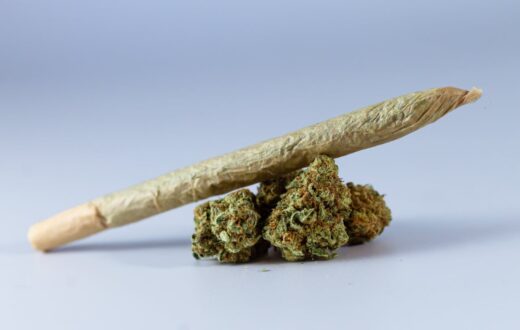Introduction to BC God Bud
BC God Bud is a renowned cannabis strain that has gained significant popularity among growers for its unique characteristics and favorable cultivation traits. Originating from the beautiful region of British Columbia, this strain is a hybrid that combines the rich genetics of the famous Hindu Kush and the potent Purple Kush. This genetic background contributes to its distinguished profile, making BC God Bud highly sought after in the cannabis community.
One of the notable qualities of BC God Bud is its balanced hybrid nature, offering a harmonious blend of both Indica and Sativa effects. This balance allows growers to enjoy a versatile plant that can produce a calming yet uplifting effect, catering to a variety of consumer preferences. The strain typically exhibits a robust growth structure, with dense, vibrant green buds that are often adorned with stunning purple hues. These visual attributes make it a favorite among cannabis cultivators who appreciate not only potency but also aesthetic appeal.
BC God Bud is particularly suitable for both novice and experienced growers alike. New cultivators appreciate the strain’s resilience and relatively forgiving nature, which allows for a smoother growing experience. Consequently, it has become a staple in home grow operations. Meanwhile, seasoned growers are drawn to its high yield potential and exceptional potency levels, as BC God Bud often boasts a THC content ranging from 18% to 24%. Additionally, its fragrant profile—characterized by sweet, earthy notes—further enhances its desirability, making the cultivation process rewarding on multiple levels. Overall, understanding how to grow BC God Bud regular strain effectively can lead to bountiful harvests and high-quality cannabis products.
Understanding Regular Strains
Regular cannabis strains are varieties that are produced naturally and can reproduce both male and female plants. This type of strain is significant in the cultivation community as it allows growers to experience the full spectrum of genetic diversity, which is often compromised in other types of cannabis strains. Unlike feminized strains, which are engineered to produce only female plants, or auto-flowering varieties, which flower based on age rather than light cycles, regular strains provide both male and female options, enabling a more authentic growing experience.
The reproductive characteristics of regular strains are paramount in understanding their cultivation. When growing regular cannabis, it is essential to manage both male and female plants appropriately, as males are necessary for breeding purposes. By carefully selecting the best male and female plants, growers can create hybrids that express desired traits, such as potency, high yield, and disease resistance. This is one of the critical advantages of learning how to grow BC God Bud regular strain, as it allows growers to explore and refine specific genetic applications within the cannabis family. The presence of male plants also leads to pollination, which can result in seeds that carry unique genetic variations.
Moreover, growing regular strains contributes to maintaining a healthy gene pool, which is beneficial for the overall cannabis ecosystem. This genetic variability can lead to plants that are better adapted to their environments and can provide certain resilience against pests and diseases. As growers focus on cultivating strains like BC God Bud regular strain, they not only enhance personal grow techniques but also contribute to broader preservation efforts of cannabis biodiversity. The practice emphasizes traditional cultivation methods and ensures a richer tapestry of cannabis genetics for future growers.
Ideal Growing Conditions for BC God Bud
To successfully cultivate the BC God Bud regular strain, understanding the optimal growing conditions is crucial. This strain thrives when provided with the right environment, which enhances its potential yield and quality. The first factor to consider is temperature. Ideally, BC God Bud prefers a temperature range between 70°F and 80°F (21°C to 27°C) during the day and slightly cooler at night. Maintaining this temperature range is essential for the strain’s growth and flowering stages. Exceeding these temperatures can stress the plant, affecting its development and potency.
Another critical aspect is humidity. During the vegetative phase, a humidity level of about 40% to 60% is optimal, allowing the plants to absorb moisture effectively. As the plants transition into the flowering stage, it is advisable to reduce the humidity to around 40% to avoid issues with mold and mildew, which can be detrimental to the BC God Bud regular strain.
Light requirements also play a significant role in the growth of this strain. For indoor growing, using high-intensity discharge (HID) lights or full-spectrum LED lights offers the best results. BC God Bud requires about 18 hours of light during the vegetative phase and should be adjusted to 12 hours during flowering. If growing outdoors, ensure the plants receive ample sunlight, preferably six to eight hours of direct sunlight each day.
Lastly, the choice of soil is vital for nurturing BC God Bud. A well-draining, nutrient-rich soil supplemented with organic matter can provide the necessary foundation for growth. Incorporating perlite or coco coir can enhance drainage, promoting healthy root development. By adhering to these ideal growing conditions, cultivators can significantly improve their chances of successfully growing the BC God Bud regular strain.
Cultivation Techniques for High Yield
To maximize the yield of the BC God Bud regular strain, it is essential to implement effective cultivation techniques. One of the most widely used methods is topping, which involves cutting off the top of the main stem. This encourages the plant to grow multiple colas rather than a single dominant one. As the BC God Bud is a hardy strain, proper topping can significantly increase light penetration and air circulation, leading to more substantial yields.
Another effective technique is low-stress training (LST). This method involves gently bending and tying down branches to create an even canopy. LST helps in maintaining manageable plant height while maximizing light exposure across all budding sites. When employing LST, it is crucial to be patient and ensure that the branches are trained gradually to avoid any stress that may hinder growth. When learned how to grow BC God Bud regular strain, integrating LST can be beneficial for achieving a higher yield.
Proper nutrition is also paramount in cultivating BC God Bud. Selecting the right nutrients at different growth stages can significantly impact plant health and overall yield. During the vegetative stage, high nitrogen levels support leaf and stem growth, while during flowering, a nutrient-rich in phosphorus and potassium promotes robust flowering. Regularly monitoring nutrient levels and adjusting based on the plant’s response is vital for their success.
In addition to training techniques and proper feeding, managing plant health is crucial. Regular inspections for pests and diseases can prevent infestations that will hinder yield. Integrated pest management (IPM) strategies can include the use of beneficial insects, organic pesticides, or even companion planting to create a healthier growing environment. This holistic approach ensures that growers know how to grow BC God Bud regular strain effectively while maintaining robust health in their gardens.
Nutrient Requirements and Feeding Schedule
The BC God Bud regular strain is renowned for its robust growth and high-quality yields, but achieving this requires a careful approach to nutrient management. Throughout its growth cycle, this strain has specific nutrient needs that must be met to ensure optimal health and productivity. The key to successfully growing BC God Bud lies in understanding the life cycle stages of the plant—from seedling to vegetative and flowering phases—and tailoring the feeding schedule accordingly.
During the seedling stage, the BC God Bud requires minimal nutrients. It is advisable to utilize a light, well-balanced nutrient solution that includes essential macronutrients such as nitrogen (N), phosphorus (P), and potassium (K). A diluted formula at half strength should suffice, typically applied once a week to avoid nutrient burn. As the plant transitions into the vegetative stage, nitrogen becomes increasingly important for healthy leaf and stem development. A nutrient formulation rich in nitrogen, combined with moderate amounts of phosphorus and potassium, should be administered every 5 to 7 days, gradually increasing the strength as the plants mature.
Once the BC God Bud enters the flowering phase, nutritional requirements shift. During this stage, the focus should be on promoting flower development. Therefore, a nutrient solution higher in phosphorus and potassium, with less nitrogen, is ideal. Feeding once every 5 to 7 days with a gradual increase in nutrient concentration can lead to enhanced flower formation. It is crucial to monitor the plants closely and adjust the nutrient ratios based on their response, ensuring they remain healthy throughout the flowering period.
Overall, understanding how to grow BC God Bud regular strain effectively involves a comprehensive feeding schedule tailored to each life stage. Regular monitoring of nutrient uptake and plant response will lead to successful cultivation and heightened yields.
Flowering Stage: What to Expect
The flowering stage is a critical phase in the cultivation of the BC God Bud regular strain, marking a significant transition from vegetative growth to the production of buds. Typically, photoperiod plants begin flowering when they receive 12 hours of light and 12 hours of darkness each day. For growers aiming to understand how to grow BC God Bud regular strain effectively, identifying the right moment to induce flowering is essential. This usually occurs when the plants are around one-third to half the desired height, as they will stretch during this stage.
The duration of the flowering period for BC God Bud can vary, generally lasting between 8 to 10 weeks. Observing the plants closely during this time is advised, as factors such as light intensity, nutrient levels, and environmental conditions play a significant role in the development of the buds. For optimal results, it is recommended to maintain stable conditions like temperature and humidity, which should ideally range from 65°F to 80°F and about 40-60% humidity, respectively. Such measures are likely to enhance bud density and overall yield.
As the flowering stage progresses, growers should look for specific signs of maturity. Trichome development is a key indicator; when the trichomes begin to turn from clear to a cloudy or amber color, it signifies that the plants are nearing harvest time. Additionally, the buds should grow denser and emit a strong fragrance, signaling their readiness for harvesting. During this crucial period, regular inspections can help identify any issues, allowing adjustments to be made in real-time, thus ensuring an optimal yield from the BC God Bud regular strain. By paying close attention to these factors, growers can maximize their success in producing high-quality buds.
Harvesting BC God Bud
Harvesting BC God Bud is a crucial stage in the cultivation process that significantly influences the final product’s quality, flavor, and potency. One of the most important factors to consider is the timing of the harvest. Typically, BC God Bud plants should be harvested when they exhibit a trichome color change from clear to milky white, with some amber trichomes present. This color shift indicates peak cannabinoid levels and ensures the desired effects are achieved. Monitoring the pistils is another method; when approximately 70-80% of the pistils have turned a dark color, it may also be the right time to proceed with harvesting.
Once the ideal harvest time is determined, the next step involves cutting and trimming the plants effectively. It is advisable to use sharp, sterile scissors or trimming shears to minimize damage to the buds and surrounding foliage. Begin by removing the larger fan leaves, as these do not contribute to the bud’s potency. After carefully cutting the branches down from the main stalk, proceed to trim the buds themselves. A clean trim not only improves the visual appeal of the buds but also facilitates proper airflow during the curing process, further enhancing the quality of the final product.
After trimming, the curing process begins. Proper curing is essential in preserving the flavor and potency of BC God Bud. Place the trimmed buds in glass jars, ensuring they are not overly packed to prevent moisture buildup. It is advisable to open the jars daily for the first week, creating an environment that allows excess moisture to escape and fresh air to circulate. This initial curing phase gradually develops the terpenes, leading to improved aroma and flavor profiles. With careful attention to timing, cutting, trimming, and curing, cultivators can successfully harvest BC God Bud to maximize its potential benefits.
Common Challenges and Solutions
Growing the BC God Bud regular strain can be a rewarding experience, but it is not without its challenges. This strain, although known for its hardiness, may still encounter issues that can affect its yield and quality. Some of the common challenges include pests, mold, and nutrient deficiencies, which are significant concerns for many cultivators.
Pests, such as spider mites and aphids, can invade your plants and lead to severe damage if not controlled promptly. The presence of these pests can hinder the plant’s growth, but there are effective solutions available. Regular monitoring of your plants is crucial. Implementing preventive measures such as natural predators—like ladybugs—and using insecticidal soap can help manage pest populations before they escalate. Furthermore, maintaining proper air circulation around the plants can deter many pests from settling in.
Mold is another common challenge, particularly in humid environments. The dense foliage of the BC God Bud regular strain can create the perfect conditions for mold to thrive. To combat this issue, ensuring adequate spacing between plants can improve airflow and reduce humidity levels. In addition, utilizing fungicidal treatments as a preventive measure can also be beneficial. Regular inspection of the plants for early signs of mold will allow you to take appropriate action expediently.
Nutrient deficiencies can pose significant risks as well, especially during the crucial flowering phase. Growers should be attentive to the signs of deficiencies, which may include yellowing leaves or stunted growth. To combat nutrient deficiencies, a well-balanced feeding schedule tailored to the BC God Bud regular strain is essential. The use of organic fertilizers and supplements can alleviate nutrient shortages while promoting healthy growth. Overall, proactive measures and solutions can significantly enhance the cultivation experience of BC God Bud, leading to bountiful and high-quality yields.
Conclusion and Final Thoughts
In summarizing the journey into how to grow BC God Bud regular strain, it is essential to highlight the paramount importance of thorough research prior to starting this rewarding endeavor. Understanding the specific needs and characteristics of the BC God Bud strain will significantly influence the overall growth experience and the quality of the final product. Knowledge about the required nutrients, optimal lighting conditions, and appropriate growing environment can make a substantial difference in achieving successful yields.
Patience plays a critical role in the cultivation of BC God Bud. This strain, while robust, demands careful attention throughout its growth cycle. Regular monitoring and adjustments to environmental conditions are necessary to ensure that the plants thrive. Growers should not rush the process; instead, they should observe and respond to the plants’ varying needs as they develop. This measured approach can lead to a rich harvest and the satisfaction of nurturing plants from seedlings to a bountiful yield.
Furthermore, cultivating BC God Bud provides an excellent opportunity for growers to experiment with different techniques and methods. Every grower brings a unique style and perspective to the cultivation process, which can enhance the growing experience. Engaging with the broader community, whether through forums or local growers’ groups, can also provide valuable insights and tips. Learning from others’ experiences can help refine one’s approach and encourage innovation in growing practices.
Ultimately, when considering how to grow BC God Bud regular strain, it becomes clear that a combination of knowledge, patience, and creativity is key. Embrace the journey, learn from both successes and setbacks, and develop your unique cultivation style while contributing to a vibrant growing community.













